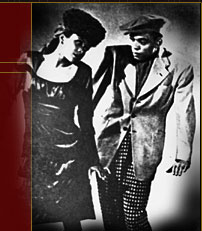

In 1991, Katherine Dunham generously donated portions of her massive collection to the Missouri Historical Society (MHS). These items represent many decades of her dance and film career, global activism, and anthropological interest. The site includes a sampling of images of artifacts (dresses, masks, shoes) located in the Missouri Historical Society Museum Collections facility and several photographs that are housed in the Missouri Historical Society Photographs and Prints Collection. This online exhibition is divided into the following sections: A Life in Profile: includes background biographical information on Katherine Dunham and her immediate family. Anthropologist: describes Katherine Dunham’s scholarly pursuits and details how her anthropological studies influenced the Dunham Dance Technique. Dancer: focuses on Miss Dunham’s personal dance career and her significant impact on the art form despite a lifelong battle with arthritis in her legs. |
Dunham Dance Technique: provides information on how this dance style developed and why it made such an impact on the dance world. Film Career: highlights some of the many movies in which Katherine Dunham and her Dance Troupe performed and includes the films that Miss Dunham choreographed. Global Activist: reveals Katherine Dunham’s stance against social, cultural, and racial inequalities. Legacy: examines the variety of people that Katherine Dunham influenced throughout her life. MHS Collections & Conservation: shares the Dunham collections at the Missouri Historical Society and describes the efforts to preserve those holdings. A special thank you to the Morris Library, Special Collections Research Center at Southern Illinois University, Carbondale; Professor Cheikh Ndiaye, Department of Modern Languages and Literatures, Union College, Schenectady, New York; and Ayoka Chenzira, Director of the Digital Moving Image Salon at Spelman College, Atlanta, Georgia, for permission to reprint images from their collections on this site. Special recognition to the staff and board of the Katherine Dunham Dynamic Museum, 532 N. 10th Street East St. Louis, IL 62201, for their continued efforts to keep Miss Dunham’s legacy alive. Katherine Dunham lived a varied and complex life. For this website the Missouri Historical Society chose the themes that we consider best to represent her legendary status. It is impossible for one source to be all-inclusive when describing a person of so many interests. If more detailed information is needed, click on Educational Materials button at the bottom of the introductory web page. Use of ContentFair Use
For questions about this site, contact Lisa Sisley-Blinn, Web Coordinator. |





